No, it wasn't the money I could be saving with Geico - it was much bigger and more rare & interesting. It was a Prehistoric beastie that I had personally never seen, and that few people do see - a monster California Giant Salamander, Dicamptodon ensatus, out for a trail trundle:
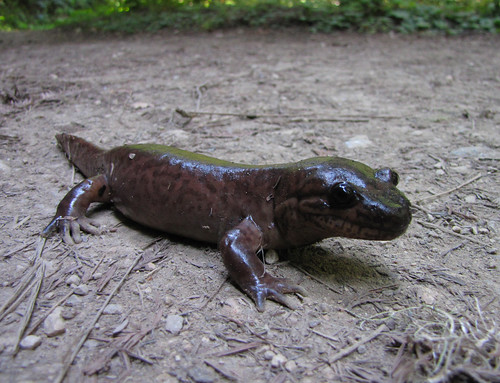
California Giant Salamander - Dicamptodon ensatus

Love the mottled skin pattern - it can range from tan to reddish to dark brown
Btw - when I say monster, I'm not trying to over sell it. Because this was no everyday finger-sized salamander or newt - this amazing critter was 12 inches long (30 cm), with a head almost 2 inches wide (5 cm), and a body the size of a TiVo remote!
Here it is next to my size 13s, and also in my big hand:
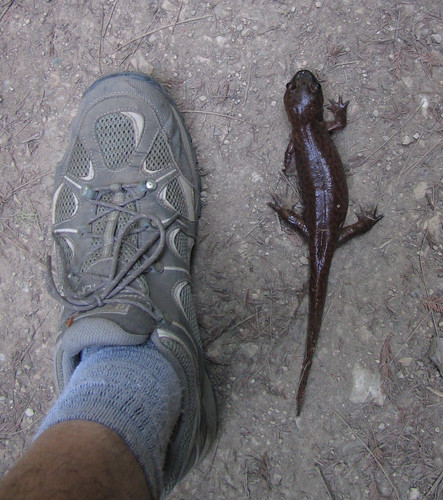
A foot long Sally - you can also see the flattened tail for swimming

A California Giant Salamander in the hand... barks at you!
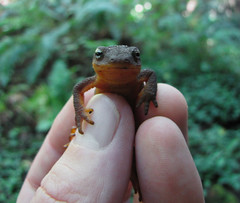
Rough-skinned Newt from the same area,
in the same hand, for size comparisons
First great thing I learned about these gentle giants - they have no problem just lounging while you stick a super-macro camera all up in their face. I.e., they're very paparazzi friendly. I guess being cold-blooded while living in deep shade means you have to be frugal with energy use. You can't run away all the time. Sometimes you gotta try to look like a stick, or go with the 'ole googly stare down that says you're confident that whoever found you "does not wanna piece o' you."
While I snapped shots of this beauty, a few mountain bikers whizzed by. Hmmmm... I had visions of salamander speed bumps. So, I decided to relocate the beastie off-trail before I continued on. So, I picked it up - and it started barking at me! The barks sounded like a cross between a big frog "erp" and one of those dogs without voices, a Basenji. It stopped as soon as I set it down. Unfortunately, I didn't think to turn on my camera's mp3 recorder, so I could share it. Next time.
I left the giant sally to enjoy its day, knowing it had already made mine. Once I got home I instantly dove into the web to get to know my new forest friend. Here's the good bits I learned:
Dicamptodon salamanders first appear in the known fossil record about 120 million years ago, in the Cretaceous Period, when the Earth was hot and wet and Pangaea was breaking up into the continents that we know and love today. 55 million years before the Dinosaur extinction!
They're considered Near Threatened because they live only in small clusters in damp woods in the San Francisco Bay Area and Santa Cruz Mountains - from Mendocino to Monterey. There's also 3 sister Dicamptodon species that live in the foggy coastal forests up the Pacific, through Oregon, Washington and into Canada, as well as in the large streams & forests of the Rocky Mountains of Idaho & Montana.
They can breed in spring and fall, and lay their eggs under logs or rocks in streams. Their young/juvenile "larvae" (think tadpoles) have gills and live in small pools for years before transforming into the adult terrestrial form.
Giant salamanders have been known to eat banana slugs, such as Ariolimax californicus. That's cool. Maybe that's why the slickery-skinned beast was there - it was hunting banana slugs. There's lots of 'em along that trail.
==
Round 2
Well, recently I was back in the same park for the same hike (as I said - it's a fave), and happened across ANOTHER Cali giant sally out on the trail in the same area and in the same manner. This one was a little smaller (about 9 inches), but still quite impressive:
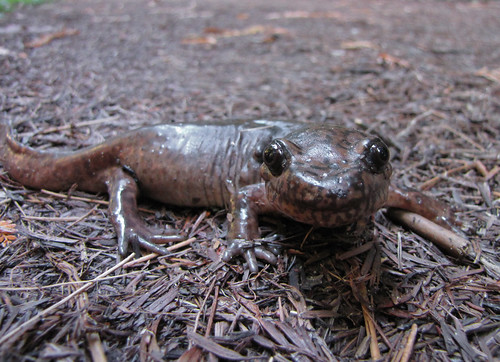
My 2nd Cali Giant Sally!
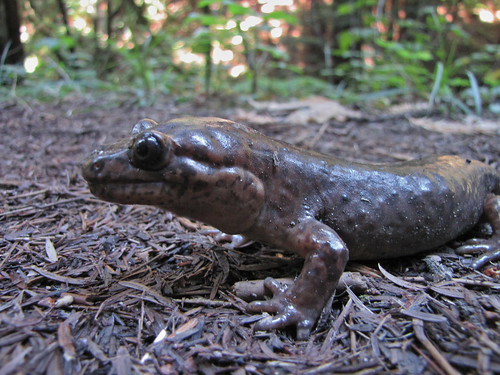
Those are some serious looking jaw muscles...
That banana slug factoid popped into my brain. There were bslugs all over, and they seemed to like the edges of the trails - perhaps for the horse apples & decaying trail trimmings. Or, maybe to hide from the giant sallys. Or, possibly, the sallys were coming out to the trail to be able to see some distance and look for the neon yellow slugs (yes, salamanders have color vision). Off-trail it gets pretty dense and hard to see when your eyes are only 2 inches off the ground.
I decided to try a little artificial natural selection, so I picked up a medium-sized bslug that was roaming nearby, and plunked it down in front of the Giant Sally. The slug slowly unfurled from its defensive ball, stretched out, and started creeping - right towards the Cali giant sally. Before I could even snap off the 1st pic of their close encounter, the previous frozen-in-time sally suddenly looked right at the slug, and lunged forward and gulped up the front 1/2 of it!
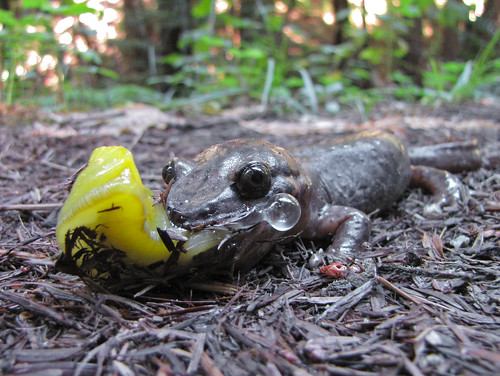
Yum! California Giant Salamander eating a banana slug. Wonder how they deal with the foul-tasting mucus the slugs pump out?
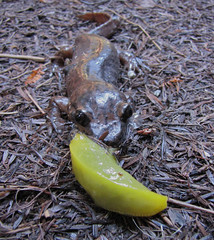
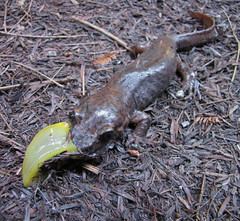
Sally was taking forever to gobble the slimer down, so I didn't wait for the entire snack break. And, since it was only at the very edge of the trail, I opted not to move it. Instead, I decided to poke around the creek to see if there was any California giant salamander larvae to be found, and in no time at all I saw several, including this little cutie:
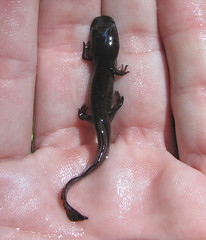
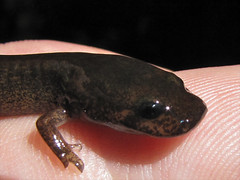
California Giant Salamander Larvae
Also saw a larvae about twice the size of the one pictured above. Glad to see that these guys are doing OK around there. Although, I guess I don't know how well they've done in the past.
I'll close with some photos that show why the salamanders and I love Purisima Creek Redwoods Open Space Preserve so much. From the year-round creek, to the drippy canopy-covered trails, maidenhair ferns, mossy oaks, doug firs, and towering 2nd-growth redwoods, it's a special park. And, it's only 75 degrees in the peak of summer when it's 95 degrees a couple of miles away on other side of Coast Range! A true testimony to Mark Twain's famous quote "The coldest winter I ever saw was the summer I spent in San Francisco." Ah, the micro climes of the Bay Area.
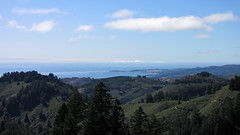
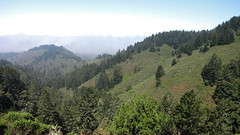
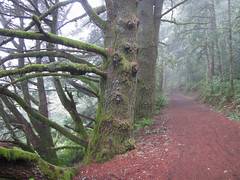
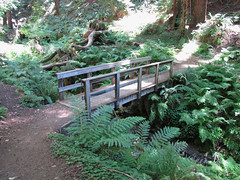
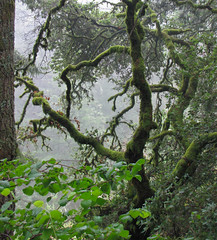
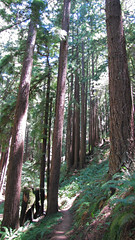
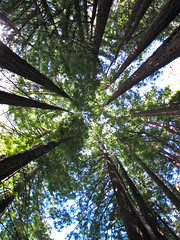
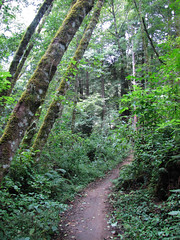
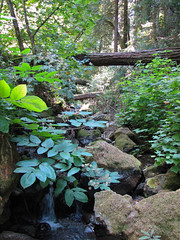
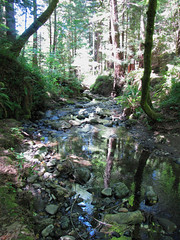
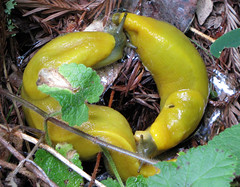
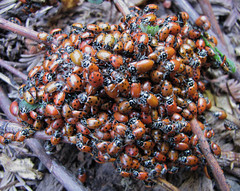
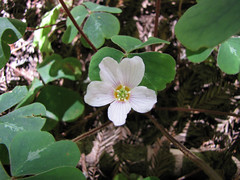
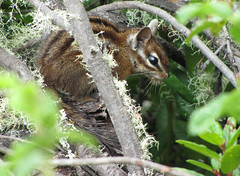
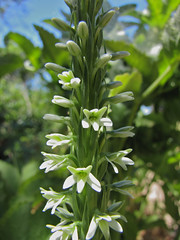
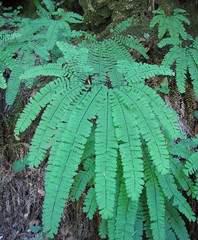
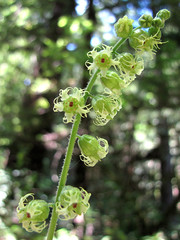
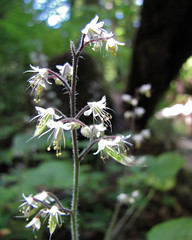
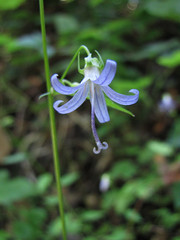
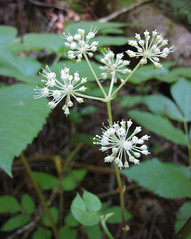
Pictured above: Purisima Creek Redwoods Park, Douglas Firs, California Redwoods, Banana Slugs, Convergent Lady Beetles, Redwood Sorrel, Merriam's Chipmunk, Elegant Rein Orchid, Five Finger Maidenhair Fern, Fringe Cups, Sugar Scoop, California Harebell, and Elk Clover.
Btw - these encounters have inspired me to start carrying a few plastic Army men with me on my hikes. Get ready for a "Creature from the Babbling Brook" diorama. :)
====
Interesting factoids:
- The only bigger salamander in North America is the Hellbender, a beast from back East that lives in the large rocky streams of places like the Alleghenies and Ozarks, and can reach a total length of 30 inches (74 cm)! However, the Hellbender is only the 3rd largest salamander in the World - China and Japan have much larger species - the Chinese Giant Salamander can reach 6 feet (180 cm) in length and weigh over 60 pounds (30kg)!!
- In European history & mythology, salamanders are often pictured as elementals of fire. The idea likely originated from salamanders' tendency to live under the bark of logs, and then come scrambling out when their log was thrown on a fire. This, coupled with the fact that many salamanders have red coloring, turned into the legend that sallys were born of flame.
References:
- Rock Paper Lizard - Quest for the Giant Salamander Part 1, Part 2
- California Herps - Dicamptodon ensatus
- Amphibia Web - Dicamptodon
- Tree of Life - Dicamptodontidae
- Wikipedia - California Giant Salamander
- Wikipedia - Salamander
- Wikipedia - Hellbender
- Wikipedia - Chinese Giant Salamander
- Wikipedia - Santa Cruz Mountains
- Wikipedia - Cretaceous Period
- Wikipedia - Purisima Creek Redwoods Open Space Preserve
- Midpeninsula Regional Open Space District - Purisima Creek Redwoods

Great post! Very nice pictures, and spectacular creatures. The CGS I wrote about was only about half the size of first one you showed. The flattened head shape of the larval form is distinctly different. Very neat.
ReplyDeleteWow, great find and exciting post. You are one lucky man. Finding an adult Dicamptodon -- wow -- very auspicious. Something equally exciting will soon happen at your camera traps.
ReplyDeleteThanks Hugh! I was hoping you'd like it - it's because of your writing that I knew what it was when I saw it.
ReplyDeleteThank you too Codger - for the kudos and the wishes of fortune! The cameras are in good spots for cougars and bears and other predators, so maybe I'll get some solid shots when I pick em up in a few weeks.
This is great! I am forwarding this link to my aunt and uncle who live in Oregon and are quite fond of the salamanders that live in their ponds. This guy is so darn cute, and I love his "googly eyes."
ReplyDeleteI call the young of any species, "babies," but then...I AM female.
I have to admit, my favorite pic is the one with the banana slug oozing clear slime like a (not so) tasty sauce to go with the meal.
Great natural history factoids too, just all-around, wonderful post. Thanks!!
I enjoyed this post. Anytime you can combine herps and humor, you have a great post.. and what a beautiful area to hike in ..... Michelle
ReplyDeleteMy Hoh-snapping turtles
This comment has been removed by a blog administrator.
ReplyDeleteVery Very Very cool! My little bro found a salamander in our grandparents' garden...it's not quite as large as the one you found...its head is about the size of your pinkie's fingernail...not actually quite sure if it really is a salamander...any ideas on what it is?????
ReplyDeletePLEASE REPLY!
Hi Kelsey - if it's slickery and shaped like a lizard, then it's very likely a salamander or newt. Newts being like sallys, but having bumpy skin and living more on land, like toads are to frogs. There's different kinds of sallys all over the world, small and large, so you might try image searches on Google for "_____ salamanders in ____" and put in info in the first blank about the color, spots, etc. and in the second blank put info about where you live, to create a search such as "orange salamander san francisco bay area"
ReplyDeleteBtw - if you did that already and ended up on my site because you're in the SF Bay Area and found a brown sally with a head the size of a fingernail, then you might try looking up "slender salamanders" and "arboreal salamanders" for pics. They're two local species often found in backyards.
:)
Hanks randomtruth! I will try that....what do salamanders eat???
ReplyDeleteThanks*
ReplyDeleteFantastic Photos! I work for PG&E up in the Santa Cruz mountains and I came across one of these guys just waddling across a driveway, I nearly passed over it with my truck. I feel lucky to have had the privilege to see it now that I know how rare such an encounter really is.
ReplyDelete